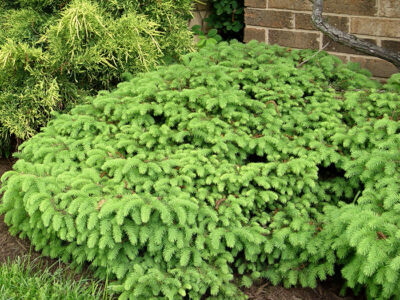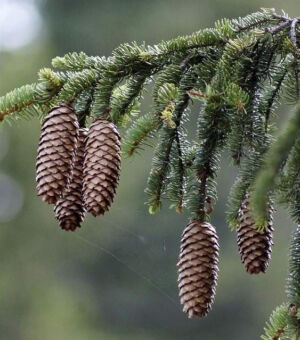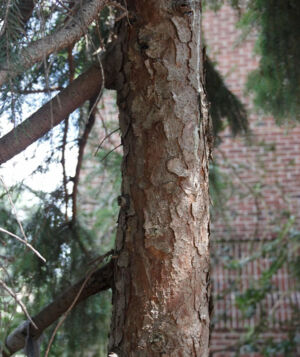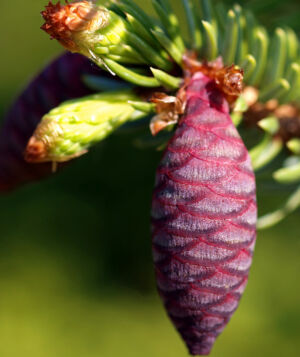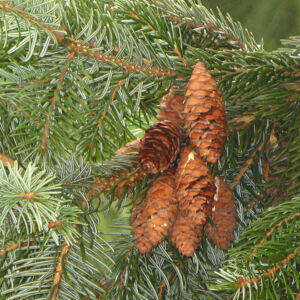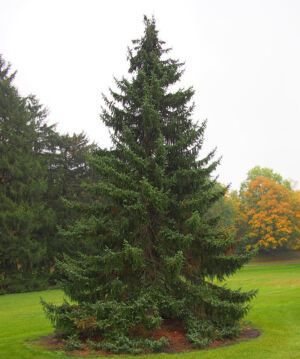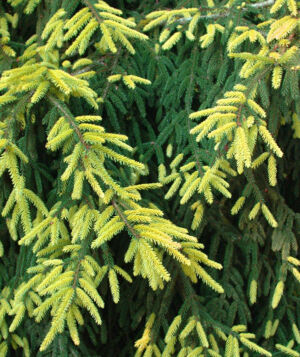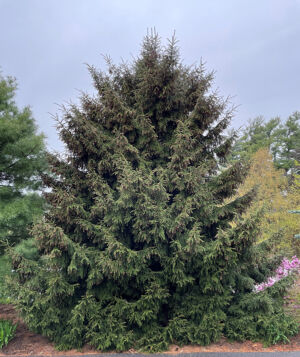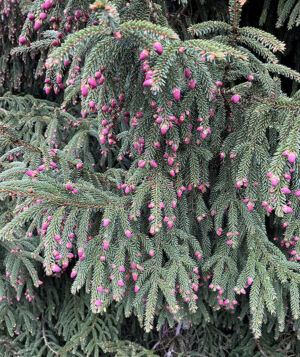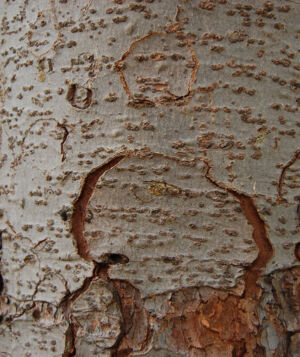Norway Spruce – Picea abies
Description
General: A pyramidal evergreen with pendulous branchlets growing 40 to 60’in height on the landscape, but up to 100+’ in the wild.
Leaves: Primary branches are slightly upturned while secondary branches are pendulous. Needles on these branches are spirally arranged, overlapping and deep shining green, up to 1” long.
Bark: Thick, with small thin, gray-brown flaking scales.
Flowers: Female flowers are cone shaped, showy, spread on the crowns of the trees and are a reddish pink in color.
Fruit: Cylindrical, pendulous cones, 4 to 6” long. Purple or green in youth and light brown with maturity.
Attributes: Used in large parks and woodlands, as windbreaks or screens. Dwarf cultivars are used as foundation plantings.
Culture
Hardiness: Zones 3-7.
Growing Conditions: Prefers moist, sandy, acid well drained soils but is tolerant of many soil types with adequate moisture. Prefers cold climates and full sun.
Maintenance: Susceptible to gall aphid, bagworm, borer, canker and needlecast.
Transplanting: Roots are shallow and spreading so care must be taken when transplanting to provide a moist, draining location.
Our Experience
Experience at Great Hill
While several large specimens grow naturally throughout the woodland border along the landscape, we’ve utilized cultivars of smaller sizes that retain their pendulous attributes on the landscape for aesthetic appeal.
Colorado Spruce – Picea pungens
Description
General: A dense, narrow to pyramidal evergreen with horizontal branches. Grows 30 to 60′ high with a 10-20′ spread in the landscape, growing over 100′ in the wild.
Leaves: Rigid, stout and prickly needles. Gray-silver to blue- green depending on the tree, 3/4 to 1 1/4″ long.
Bark: Grey to reddish brown and scaly.
Flowers: Monoecious. Greenish or purple.
Fruit: Oblong, cylindrical cones 2-4″ long. Yellow brown when mature with wavy scales.
Attributes: Popular as a specimen and foundation plant, especially blue needled cultivars.
Culture
Hardiness: Zones 3-7.
Growing Conditions: Prefers rich, moist soil and full sun but is adaptable to many different sites and tolerates drought well.
Maintenance: Susceptible to spruce gall aphid, budworm, spidermite and canker.
Transplanting: Transplants easily.
Our Experience
Experience at Great Hill
We utilize blue needled colorado spruce cultivars to add color and texture appeal to the landscape. One in particular, Picea pungens ‘fat albert’ is a slow growing, compact, pyramidal tree of which we have two, mirroring each other at either side of our formal garden.
Serbian Spruce – Picea omorika
Description
General: A spire like evergreen with a slender trunk and short ascending branches. Serbian spruce is a graceful tree that typically has a pyramidal shape (though it does vary), and grows to 60′.
Leaves: Overlapping, flat, dark green needles up to 1″ long.
Bark: Brown with scaly plates.
Flowers: Monoecious. Strawberry shaped and colored. 1/2- 3/4″ long.
Fruit: Pendant cones, 2 1/2″ long. Emerge purple and mature to cinnamon brown.
Attributes: Makes a wonderful specimen and street tree. Noted as one of the more attractive spruce trees.
Culture
Hardiness: Zones 4-7.
Growing Conditions: Prefers rich, moist, well draining soil and part sun. Favors a dry atmosphere but is very adaptable.
Maintenance: Susceptible to aphids, budworm and borers.
Transplanting: Transplants easily.
Our Experience
Experience at Great Hill
We utilize Picea omorika ‘Nana,’ a slow growing, broad, conical dwarf form of serbian spruce as a specimen tree. It adds shape and evergreen interest to the front of the main house.
Oriental Spruce – Picea orientalis
Description
General: A dense, narrow, compact and pyramidal spruce with pendulous, horizontal branches growing to 60′ in cultivation and up to 120′ where wild.
Leaves: Very short and tightly set needles grow to 1/2″ long. Flattened, glossy and dark green.
Bark: Brown exfoliating in thin scales.
Flowers: Monoecious. Strawberry shaped and colored. 1/2- 3/4″ long.
Fruit: Cones are 2 to 4″ long emerging purple and maturing to brown
Attributes: The graceful and attractive habit of Oriental spruce make it a high quality specimen tree for small areas .
Culture
Hardiness: Zones 4-7.
Growing Conditions: Prefers rich moist soil but is very tolerant of poor gravely soils. Grows in full sun to part shade. Needs protection from harsh winds.
Maintenance: Susceptible to needlecast, cankers, rust, aphids, budworm and borers.
Transplanting: Transplants easily.
Our Experience
Experience at Great Hill
We have a couple of oriental spruce cultivars on the hill, ‘Skylands’, and ‘Aurea.’ The young shoots of aurea are a golden creamy yellow color which gives the entire tree a golden sheen during the spring and skylands is a dwarf cultivar with golden needles. Their habit and color add to the diversity of the landscape.



